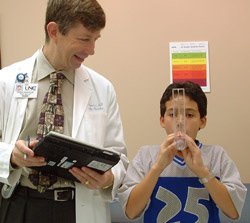Ozone and Your Patients' Health: About this Course
Ozone and Your Patients' Health is designed for family practice doctors, pediatricians, nurse practitioners, asthma educators, and other medical professionals who counsel patients about asthma, air pollution, or exercise. Patients and their families may also use this material to learn the science behind ozone’s effect on respiration and how to manage their respiratory health using the Air Quality Index.
Course Objectives
Upon completion of this course, you will be able to:
- Describe how ozone is formed and where it is found
- Identify the effects that exposure to ozone has on the general population
- List the different effects of ozone at varying exposure concentrations and durations
- Identify the effects that ozone has on asthma patients
- Explain the purpose and use of the Air Quality Index
- Identify common sources of information about the Air Quality Index
- Address typical patient questions and clinical scenarios relating to ozone exposure
How to Use This Training
You can complete this course in order by using the PREVIOUS and NEXT links at the bottom of each page or you can use the navigation links in the sidebar at the left to take the training in whatever order you choose. Total time to complete the course is approximately 1.5 hours. The training modules include the following:
What is Ozone? - How ozone is formed and where it is found.
Health Effects in the General Population - Health effects that are observed in broad segments of the population, including respiratory symptoms, reduced lung function, and airway inflammation.
Health Effects in Patients with Asthma and Other Chronic Respiratory Disease - Focuses on the population that has been identified to be the most acutely responsive to ozone exposure.
Patient Exposure and the Air Quality Index - Explains the purpose and use of the Air Quality Index.
Clinical Scenarios - 4 clinical scenarios to test your knowledge.
Frequent Questions - Information for counseling patients about ozone, asthma, and respiratory symptoms.
Course Outline/Key Points - Outline of the course and key points in each section.
Review Questions - Test your knowledge.
Patient Education Tools - Includes downloadable publications (with a link to Spanish publications) and links to related EPA Web pages.
References & Figures - The references used for the course development and a compilation of the figures in the course.
Participation Certificate - Pdf file you can print and fill out for your records.

